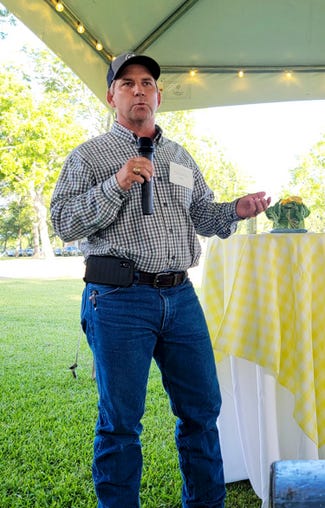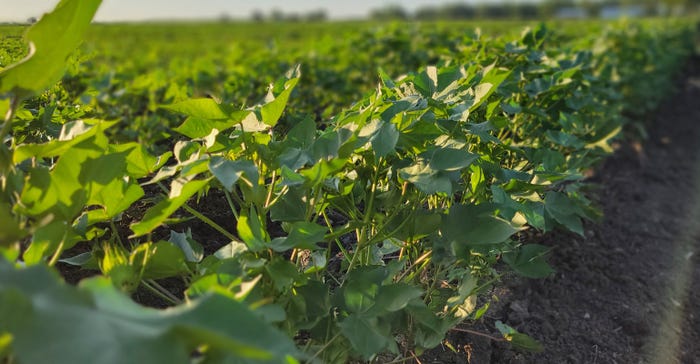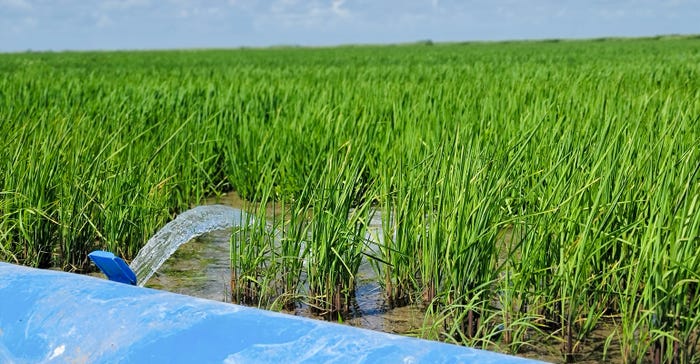
Matagorda County, Texas, producer Daniel Berglund.Shelley E. Huguley
Drought has heightened production risks for many Southwest producers, including those who farm along the Texas Coast. But recent moisture has producers hopeful.
Daniel and Dillon Berglund farm in Matagorda, Wharton and Jackson counties. In 2021, they received nearly 60 inches of rainfall. In the first half of 2022, they've only received 8.5inches, altering their production acres.
"Between us, we normally have somewhere between 1,500 and 2,000 acres of corn. This year, we didn't have moisture to plant based on a wet 2021 harvest and not getting land prepared timely," Daniel says. "This year, we've only got about 200 acres of corn between the two of us."
Much of the ground the Berglunds are planting to row crops was in rice last year. Daniel says converting that land requires a lot of work and time. "It's easy going from one (row crop) to the next as opposed to working the ground, leveling and putting rows back up and then getting enough moisture to plant .
"The corn has suffered," Daniel says. "Now that we've tried to irrigate it, and on top of that irrigation, we got about three inches of rain, it's gone from being drought-stressed to being shocked with irrigation to being drowned by rain, all at the same time.
"It's been a tough, tough year on corn."
Keith Kresta, who farms in neighboring Wharton County, echoes Daniel's sentiments. "This year's been more challenging because we started out a little bit drier than normal, and it hasn't rained. The month of May was difficult. We had 18-plus days over 90 degrees and that was a critical time when the crops needed to establish their fruiting structures."
 "Farming has always been a passion of mine, a passion with a purpose," says Keith Kresta at the recent 2022 Field to Fork event, Wharton County. (Photo by Shelley E. Huguley)
"Farming has always been a passion of mine, a passion with a purpose," says Keith Kresta at the recent 2022 Field to Fork event, Wharton County. (Photo by Shelley E. Huguley)
He says the recent moisture is too little too late for some of his corn. "But there's still some opportunity there."
Inputs
As challenging as drought is, so is the cost of inputs, Kresta says. "Fertilizer is 2.5 times higher, diesel has doubled. A lot of our inputs are higher, so our risk factor is elevated greatly in growing this crop."
Despite the hike, Kresta won't make cuts. "The unique thing about corn, soybeans, cotton, milo, any of your crops, is they need what they need," Kresta says. "They need essential elements, regardless of the price, so it's important to know your soil, yield potential and your goals.
"Farmers are by far your best environmentalists. So, I think people are sharpening their pencils and doing the best job they can to apply the right amount of nutrients to maintain the crop."
Cotton
On the Berglunds' farm, acres initially intended for corn, have been planted to cotton. "Some of it's doing really well and some of it has a thin stand because of lack of moisture at planting. West of us, in Jackson County, we had some that didn't even come up."
Our earlier-planted cotton has responded well to the recent precipitation, Daniel says. "Luckily, we got the rain. It's perfect for it. It's growing really well."
The moisture deficit forced Dillon to plant his cotton later. "It's small for the rain that we got," Daniel says. "On the top end of the fields, it's fine. At the bottom end, it's water-stressed, so we need to get in there and air it out, cultivate it, and get it going."
Cotton making progress on Keith Kresta's farm. (Photo by Shelley E. Huguley)

Late-planted cotton and therefore a later harvest is risky business along on the Texas Coast. "The later it gets, we have more risk with tropical storms and hurricanes."
Some of Kresta's cotton has received less than an inch rain since March when it was planted. "That's definitely created some challenges," he says. "The cotton has the most potential to recover. If we can get some later-season rains, due to its indeterminate nature and tap root, we can still recover this cotton crop."
Rice
The Berglunds also produce commercial rice and, since 2016, hybrid seed rice for RiceTec. Their rice was planted early and included a few rain delays, "which is where we also got the moisture to plant our corn and cotton." But Daniel says it's been unseasonably hot for his young rice crop. "We have rice that's anywhere from young tillering rice to rice that's going to permanent flood to rice that's at reproductive stage. So, it's really spread out, which is not a bad thing. That helps at harvest. But a lot of that's due to weather more so than planning."
 Daniel Berglund increases watering efficiency utilizing multiple inlet water applications. (Photo by Shelley E. Huguley)
Daniel Berglund increases watering efficiency utilizing multiple inlet water applications. (Photo by Shelley E. Huguley)
Later this month, once the rice starts heading the Berglunds will begin scouting for stink bugs. Typically, they treat with the insecticide Tenchu. But this year that may not be an option.
"It's in short supply in the world and it's held up in Mexico customs. They don't know when it's going to be released," says Daniel, who helped get EPA approval for the foreign-made insecticide.
Another option could be Endigo ZC, a Syngenta insecticide, but it lacks full label usage. "We had a section 18 for rice delphacid only. When we've used it for the rice delphacid, it's shown to be very effective on rice stink bugs. So, we're trying to get Syngenta and the EPA to pick this up and get us some relief in the next three weeks because we're going to start spraying the commercial rice that was planted in March."
Supply chain holdups have impacted Kresta's operation as well. In October, he ordered a Dodge Ram 4500 work truck. "The status hasn't changed since Oct. 1., and we're talking just a basic work truck that we need for the farm, and we can't get it."
With hurricane season looming, his biggest apprehension is harvest. "If we're unable to get parts for harvest machinery, that can cause serious financial burden if you can not get your crop out in a timely manner. And there are concerns that equipment might not be available. We've seen it with tractors. There are parts we've waited up to 6 months for."
Rain
Daniel says June rains make grain. If it doesn't rain, they'll irrigate where they can. The Berglunds irrigate from 950-foot wells, and Kresta from 350-450-foot wells. Both draw from the Chicot Aquifer.
Irrigating on the coast can be tricky, Daniel says. In May, when they had just finished irrigating their corn, we received rain "overnight," which is what stunted the corn's growth. "That's the thing on the Gulf Coast when you're irrigating, you never know if it's going to be timely or if you're going to get a big rain. There weren’t big rains in the forecast."
There's a lot weighing on producers this season.

Keith Kresta's cotton. Both Daniel Berglund and Keith Kresta agree the stress and risk this season is high. (Photo by Shelley E. Huguley)
"If you farm long enough, you will go through these droughts," Kresta says. "But this year, the reason there's more anxiety is the financial situation is compounded by the fact that the inputs are so much higher, in one year, than we've ever seen before since I started farming. That's a high-level of stress."
About the Author(s)
You May Also Like






